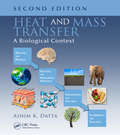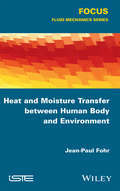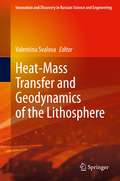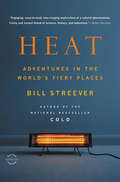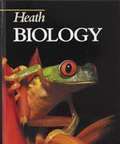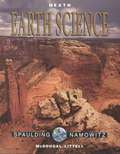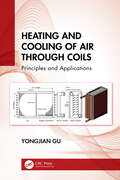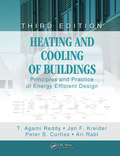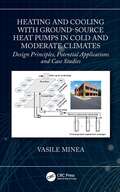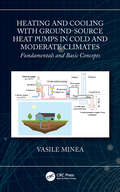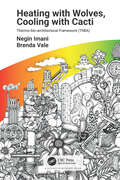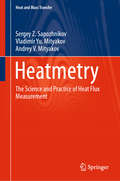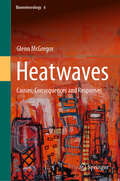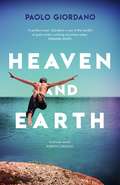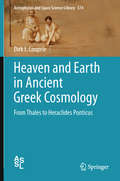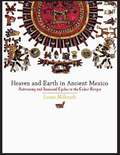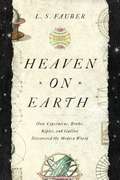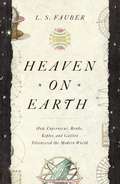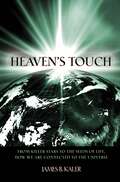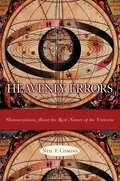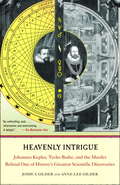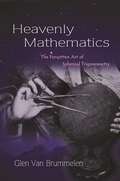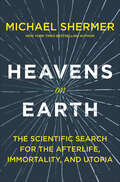- Table View
- List View
Heat and Mass Transfer: A Biological Context, Second Edition
by Ashim K. DattaThis substantially revised text represents a broader based biological engineering title. It includes medicine and other applications that are desired in curricula supported by the American Society of Agricultural and Biological Engineers, as well as many bioengineering departments in both U.S. and worldwide departments. This new edition will focus
Heat and Moisture Transfer between Human Body and Environment
by Jean-Paul FohrHuman adaptation under cold or hot temperatures has always required specific fabrics for clothing. Sports or protective garment companies propose to improve performance or safety. Behind thermal comfort lays many physical/physiological topics: human thermoregulation loop, natural or forced convection, heat and vapor transfer through porous textile layers, solar and infrared radiation effects. This book leads through progressive and pedagogic stages to discern the weight of all the concerned physical parameters.
Heat-Mass Transfer and Geodynamics of the Lithosphere (Innovation and Discovery in Russian Science and Engineering)
by Valentina SvalovaThis volume is devoted to investigation of all aspects of heat-mass transfer processes at different scales and from various origins, as well as the formation and evolution of geological structures. These phenomena are linked to geophysical properties of rocks, geothermal resources, geothermics, fluid dynamics, stress-state of the lithosphere, deep geodynamics, plate tectonics, and seismicity, among others. The book consists of two main parts. The first concerns heat-mass transfer associated with natural and technogenic processes in the upper lithosphere. The second deals with geodynamics and seismicity. The collection of over 25 chapter from leading investigators in Russia is thus an important contribution to research on the lithosphere in connection with formation and evolution of geological structures; heat and mass transfer processes in the lithosphere and their connection with deep Earth geodynamics. Collects a range of research methodologies including application of modelling, seismic tomography, geological field works, geological-geophysical methods, and in situ measurements through instrumentation;Explains how a wide range of geological and geophysical phenomena arising in the Earth’s lithosphere can be investigated under the umbrella of a common approach to heat-mass transfer processes;Includes the latest research by more than 60 leading scientists from Russia.
Heat: Adventures in the World's Fiery Places
by Bill StreeverAn adventurous ride through the most blisteringly hot regions of science, history, and culture. Melting glaciers, warming oceans, droughts-it's clear that today's world is getting hotter. But while we know the agony of a sunburn or the comfort of our winter heaters, do we really understand heat?A bestselling scientist and nature writer who goes to any extreme to uncover the answers, Bill Streever sets off to find out what heat really means. Let him be your guide and you'll firewalk across hot coals and sweat it out in Death Valley, experience intense fever and fire, learn about the invention of matches and the chemistry of cooking, drink crude oil, and explore thermonuclear weapons and the hottest moment of all time-the big bang.Written in Streever's signature spare and refreshing prose, HEAT is an adventurous personal narrative that leaves readers with a new vision of an everyday experience-how heat works, its history, and its relationship to daily life.
Heath Biology
by James E. Mclaren Lissa Rotundo Laine Gurley-DilgerThis 8 unit study program discusses topics on Introduction to Biology, Genetics and Evolution, Microbiology, Plants, Invertebrates, Chordates, The Human Body, and Ecology.
Heath Earth Science
by Nancy E. Spaulding Samuel N. NamowitzYou live on Earth! Everything you have or use, whether it is this book, your breakfast, your favorite clothes, the bus you rode to school in, or anything else, comes from materials found on Earth. Any place that you are likely to visit or live is on Earth. Everything you see or hear takes place on Earth, in its atmosphere, or in the universe. Since you will be involved in so many aspects of Earth and the universe in your lifetime, it makes sense that you should know something about them. Also, with an understanding of earth science, you will be able to make more informed choices about how you conserve and use Earth's resources.
Heath Earth Science (Grades 9-12 #1999)
by Nancy E. Spaulding Samuel N. Namowitz Mcdougal Littel Margaret A. LemoneA secondary school textbook introducing such earth sciences as geology, meteorology, and oceanography. Includes study questions at the end of each chapter.
Heating and Cooling of Air Through Coils: Principles and Applications
by Yongjian GuHeating and Cooling of Air Through Coils combines theory and practice to cover the fundamentals in the processes of heating and cooling of air through coils and the key aspects in the psychrometric chart, the coil fluid piping systems, the coils, and the energy sources for the fluid in the coils. This book covers the integral elements that have a significant impact on the heating and cooling of air through coils, including the coil types, coil tube constructions and arrangements, and fluid flow characteristics in the coils. It also discusses sustainable and renewable energy sources used to heat and cool the fluid flowing in the piping system and the coils. In addition, the book covers the application of coils in central air-conditioning systems and split air-conditioning systems. Presents the fundamentals of heating and cooling of air through coils. Explains the psychrometric chart used for assessing the physical and thermodynamic properties of air in the heating and cooling processes. Covers numerous coil types and constructions. Discusses the key equipment used in the coil fluid piping systems that deliver hot water, steam, condensate, and chilled water to and from the coils. Considers various energy sources to the fluid in the coil piping system for heating and cooling, including solar heat energy, ocean thermal energy, and geothermal energy. This book will interest engineers and researchers involved in the design and operation of heat exchangers and HVAC systems. It can also be used as a textbook for undergraduate and graduate students majoring in relevant fields, such as thermal and fluids HVAC, and energy management.
Heating and Cooling of Buildings: Principles and Practice of Energy Efficient Design, Third Edition (Mechanical and Aerospace Engineering Series)
by T. Agami Reddy Ari Rabl Jan F. Kreider Peter S. CurtissHeating and Cooling of Buildings: Principles and Practice of Energy Efficient Design, Third Edition is structured to provide a rigorous and comprehensive technical foundation and coverage to all the various elements inherent in the design of energy efficient and green buildings. Along with numerous new and revised examples, design case studies, and homework problems, the third edition includes the HCB software along with its extensive website material, which contains a wealth of data to support design analysis and planning. Based around current codes and standards, the Third Edition explores the latest technologies that are central to design and operation of today’s buildings. It serves as an up-to-date technical resource for future designers, practitioners, and researchers wishing to acquire a firm scientific foundation for improving the design and performance of buildings and the comfort of their occupants. For engineering and architecture students in undergraduate/graduate classes, this comprehensive textbook:
Heating and Cooling with Ground-Source Heat Pumps in Cold and Moderate Climates: Design Principles, Potential Applications and Case Studies
by Vasile MineaHeating and Cooling with Ground-Source Heat Pumps in Cold and Moderate Climates: Design Principles, Potential Applications and Case Studies focuses on applications and cases studies of ground-source heat pumps in moderate and cold climates. It details technical aspects (such as materials, thermal fluid carriers and pumping, and drilling/trenching technologies), as well as the most common and uncommon application fields for basic system configurations. The principles of system integrations and applications in moderate and cold climates (such as hybrid, solar-assisted, thermo-syphon, foundation, mines, snow melting, district heating and cooling ground-source heat pump systems, etc.) are also presented, each followed by case studies. Based on the author's more than 30 years of technical experience Discusses ground-source heat pump technologies that can be successfully applied in moderate and cold climates Presents several case studies, including successful energy results, as well as the main lessons learned This work is aimed at designers of HVAC systems, as well as geological, mechanical, and chemical engineers implementing environmentally-friendly heating and cooling technologies for buildings.
Heating and Cooling with Ground-Source Heat Pumps in Cold and Moderate Climates: Fundamentals and Basic Concepts
by Vasile MineaHeating and Cooling with Ground-Source Heat Pumps in Cold and Moderate Climates: Fundamentals and Basic Concepts covers fundamentals and design principles of vertical and horizontal indirect and direct expansion closed-loop, as well as ground and surface-water ground-source heat pump systems. It explains the thermodynamic aspects of mechanical and thermochemical compression cycles of geothermal heat pumps, and describes the energetic, economic, and environmental aspects associated with the use of ground-source heat pump systems for heating and cooling residential and commercial/institutional buildings in moderate and cold climates. Based on the author's more than 30 years of technical experience Focuses on ground-source heat pump technologies that can be successfully applied in moderate and cold climates Discusses technical aspects as well as the most common and uncommon application fields of basic system configurations This work is aimed at designers of HVAC systems, as well as geological, mechanical, and chemical engineers implementing environmentally-friendly heating and cooling technologies for buildings.
Heating with Wolves, Cooling with Cacti: Thermo-bio-architectural Framework (ThBA)
by Brenda Vale Negin ImaniThis book describes the detailed process behind the development of a comprehensive thermo-bio-architectural framework (the ThBA). This framework systematically connects the thermal performance requirements of a building to relevant solutions found in the natural world. This is the first time that architecture has been connected to biology in this manner. The book provides an in-depth understanding of thermoregulatory strategies in animals and plants and links these to equivalent solutions in architectural design. The inclusion of this fundamental knowledge, along with the systematic process of accessing it, should open up new avenues for the generation of energy efficient and sustainable buildings.
Heatmetry: The Science and Practice of Heat Flux Measurement (Heat and Mass Transfer)
by Sergey Z. Sapozhnikov Vladimir Yu. Mityakov Andrey V. MityakovThis book is a translation from a Russian book. In 2007, the authors created a new generation of layered composite-based sensors, whose advantages are high technology and thermal stability. The use of gradient heat flux sensors in laboratory and industrial conditions confirmed their reliability, showed high information, and allowed a number of priority results to be obtained. All of this is summarized in this book.
Heatwaves: Causes, Consequences and Responses (Biometeorology #6)
by Glenn McGregorDistinctively, this book brings together an end-to-end understanding of heatwaves, that is, a consideration of their causes, consequences for human and natural systems and societal responses to them in the form of adaptation and mitigation actions. It advocates for recognizing "the heatwave imperative" and emphasizes that “heatwaves matter”. Together, the individual chapters make the point that “knowing heatwaves” from a holistic interdisciplinary perspective will assist with efforts towards heatwave risk reduction and building resilience to what is probably the most pervasive of a range of climate hazards. The book will be of interest to upper level undergraduate and taught postgraduate students and researchers in geography, climatology, environmental, atmospheric and population health sciences as well as climate and health researchers, urban planners, policy makers and the informed public with an interest in climate and society issues.
Heaven and Earth
by Paolo Giordano'A devastating marvel of a novel' Sunday Telegraph 'A highly enjoyable novel... Giordano is especially good on the textures, smells, heat and colours of the Italian south. These stay long in the mind, as does the way he writes about the obsessiveness of love, the way it dominates and distorts and the self-delusions and fantasies it gives rise to' TLS 'If you're pining for an Italian break, then this might be the remedy: Heaven And Earth is rooted so deep in idyllic Puglia that you can almost feel the red soil under your sandals' Daily Mail 'Raw and evocative: a breathtaking and poignant creation that will leave you itching under the skin' Herald 'A stunning achievement' André Aciman, author of Call Me By Your Name 'Perfect, moving, honest, brilliant, with characters who feel like old friends' Andrew Sean Greer, Pulitzer Prize-winning author of Less 'The perfect novel. Paolo Giordano is one of the handful of great writers working anywhere today' Edmund White Every summer Teresa follows her father to his childhood home in Puglia, down in the heel of Italy, a land of relentless, shimmering heat, centuries-old olive groves and taciturn, proud people. There Teresa spends long afternoons enveloped in a sun-struck stupor, reading her grandmother's cheap crime paperbacks.Everything changes the summer she meets the three boys who live on the masseria next door: Nicola, Tommaso and Bern - the man Teresa will love for the rest of her life. Raised like brothers on a farm that feels to Teresa almost suspended in time, the three boys share a complex, intimate and seemingly unassailable bond. But no bond is unbreakable and no summer truly endless, as Teresa soon discovers. Because there is resentment underneath the surface of that strange brotherhood, a twisted kind of love that protects a dark secret. And when Bern - the enigmatic, restless gravitational centre of the group - commits a brutal act of revenge, not even a final pilgrimage to the edge of the world will be enough to bring back those perfect, golden hours in the shadow of the olive trees.PRAISE FOR PAOLO GIORDANO 'Mesmerizing... Giordano works with piercing subtlety' New York Times'Elegant and fiercely intelligent' Elle'Elegiac, tender and mournful' Wall Street Journal
Heaven and Earth in Ancient Greek Cosmology
by Dirk L. CouprieIn Miletus, about 550 B.C., together with our world-picture cosmology was born. This book tells the story. In Part One the reader is introduced in the archaic world-picture of a flat earth with the cupola of the celestial vault onto which the celestial bodies are attached. One of the subjects treated in that context is the riddle of the tilted celestial axis. This part also contains an extensive chapter on archaic astronomical instruments. Part Two shows how Anaximander (610-547 B.C.) blew up this archaic world-picture and replaced it by a new one that is essentially still ours. He taught that the celestial bodies orbit at different distances and that the earth floats unsupported in space. This makes him the founding father of cosmology. Part Three discusses topics that completed the new picture described by Anaximander. Special attention is paid to the confrontation between Anaxagoras and Aristotle on the question whether the earth is flat or spherical, and on the battle between Aristotle and Heraclides Ponticus on the question whether the universe is finite or infinite.
Heaven and Earth in Ancient Mexico: Astronomy and Seasonal Cycles in the Codex Borgia
by Susan MilbrathThe Codex Borgia, a masterpiece that predates the Spanish conquest of central Mexico, records almanacs used in divination and astronomy. Within its beautifully painted screenfold pages is a section (pages 29-46) that shows a sequence of enigmatic pictures that have been the subject of debate for more than a century. Bringing insights from ethnohistory, anthropology, art history, and archaeoastronomy to bear on this passage, Susan Milbrath presents a convincing new interpretation of Borgia 29-46 as a narrative of noteworthy astronomical events that occurred over the course of the year AD 1495-1496, set in the context of the central Mexican festival calendar. In contrast to scholars who have interpreted Borgia 29-46 as a mythic history of the heavens and the earth, Milbrath demonstrates that the narrative documents ancient Mesoamericans' understanding of real-time astronomy and natural history. Interpreting the screenfold's complex symbols in light of known astronomical events, she finds that Borgia 29-46 records such phenomena as a total solar eclipse in August 1496, a November meteor shower, a comet first sighted in February 1496, and the changing phases of Venus and Mercury. She also shows how the narrative is organized according to the eighteen-month festival calendar and how seasonal cycles in nature are represented in its imagery. This new understanding of the content and purpose of the Codex Borgia reveals this long-misunderstood narrative as the most important historical record of central Mexican astronomy on the eve of the Spanish conquest.
Heaven on Earth: How Copernicus, Brahe, Kepler, And Galileo Discovered The Modern World
by L. S. FauberA vivid narrative that connects the lives of four great astronomers as they discovered, refined, and popularized the first major scientific discovery of the modern era: that the Earth moves around the Sun. Today we take for granted that a telescope allows us to see galaxies millions of light years away. But before its invention, people used nothing more than their naked eye to fathom what took place in the visible sky. So how did four men in the 1500's—of different nationality, age, religion, and class—collaborate to discover that the Earth revolved around the Sun? With this radical discovery that went against the Church, they created our contemporary world—and with it, the uneasy conditions of modern life. Heaven on Earth is an intimate examination of this scientific family—that of Nicolaus Copernicus, Tycho Brahe, Johannes Kepler, and Galileo Galilei. Fauber juxtaposes their scientific work with insight into their personal lives and political considerations, which shaped their pursuit of knowledge. Uniquely, he shows how their intergenerational collaboration was actually what made the scientific revolution possible. Ranging from the birth of astronomy and the methods of early scientific research, Fauber reveals the human story that underlies this civilization altering discovery. And, contrary to the competitive nature of research today, collaboration was key to early scientific discovery. Before the rise of university research institutions, deep thinkers only had each other. They created a kind of family, related to each other via intellectual pursuit rather than blood. These men called each other “brothers,” “fathers,” and “sons,” and laid the foundations of modern science through familial co-work. And though the sixteenth century was far from the an open society for women, There were female pioneers in this “family” as well, including Brahe's sister Sophie, Kepler’s mother, and Galileo's daughter. Filled with rich characters and sweeping historical scope, Heaven on Earth reveals how the strong connections between these pillars of intellectual history moved science forward—and how, without them, we might have waited a long time for a heliocentric model of the universe.
Heaven on Earth: How Copernicus, Brahe, Kepler, and Galileo Discovered the Modern World
by J. S. Fauber'What Fauber does well is humanize these four residents of the pantheon of science... The story is seldom less than fascinating. A readable, enjoyable contribution to the history of science.' - KirkusAn intimate examination of a scientific family - that of Nicolaus Copernicus, Tycho Brahe, Johannes Kepler and Galileo Galilei. Fauber juxtaposes their scientific work with insight into their personal lives and political considerations, which shaped their pursuit of knowledge. Uniquely, he shows how their intergenerational collaboration made the scientific revolution possible.These brave scientists called each other 'brothers', 'fathers' and 'sons', and laid the foundations of modern science through familial co-work. And though the sixteenth century was far from an open society for women, there were female pioneers in this 'family' as well, including Brahe's sister Sophie, Kepler's mother, and Galileo's daughter. Filled with rich characters and sweeping historical scope, this book reveals how the strong connections between these pillars of intellectual history moved science forward.
Heaven's Touch: From Killer Stars to the Seeds of Life, How We Are Connected to the Universe
by James B. KalerA breathtaking account of how the surrounding cosmos impacts life on EarthDid you know that as you read these words showers of high-speed particles from exploding stars are raining down on you? As you gaze into the starry sky, you might feel isolated from the Universe around you—but you're not. This book reveals the startling ways life on Earth is touched by our cosmic environment, and demonstrates why without such contact, life itself wouldn't be possible.Heaven's Touch embarks on an unforgettable journey across the cosmos, beginning in near space with a look at the gentle ebb and flow of lunar and solar tides. Acclaimed astronomer James Kaler describes their subtle effects on our world and also explores the Sun's more potent influences, such as solar storms that cause auroras, give comets their tails, and knock out power grids on Earth. He ventures across the Solar System to consider how the planets can act to produce climate change, even global disaster. Kaler shows how Jupiter's gravity can throw asteroids toward potentially devastating collision with Earth, and how even our whole Galaxy might hurl comet storms at us. He then takes us into deepest space to describe the cosmic rays launched at us from exploding stars, and considers not just how these exploders might harm us, but how they also join together in the creation of stars and how they serve to populate the Universe with the very building blocks of life.Informative and entertaining, Heaven's Touch reveals how intimately connected we really are with the dynamic Universe in which we live.
Heavenly Errors: Misconceptions About the Real Nature of the Universe
by Comins Neil F.One of the great paradoxes of modern times is that the more scientists understand the natural world, the more we discover that our everyday beliefs about it are wrong. Neil F. Comins has identified and classified, by origin and topic, over 1,700 commonly held misconceptions about the universe. He presents the reader with the tools needed to probe erroneous notions so that we can begin to question for ourselves ... and to think more like scientists.
Heavenly Errors: Misconceptions About the Real Nature of the Universe
by Neil CominsOne of the great paradoxes of modern times is that the more scientists understand the natural world, the more we discover that our everyday beliefs about it are wrong. Astronomy, in particular, is one of the most misunderstood scientific disciplines.With the participation of thousands of undergraduate students, Neil F. Comins has identified and classified, by origin and topic, over 1,700 commonly held misconceptions. Heavenly Errors provides access to all of them and explores many, including: Black holes suck in everything around them. The Sun shines by burning gas. Comets have tails trailing behind them. The Moon alone causes tides. Mercury, the closest planet to the Sun, is the hottest planet.In the course of correcting these errors, he explains that some occur through the prevalence of pseudosciences such as astrology and UFO-logy and some enter the public conscience through the "bad astronomy" of Star Trek, Star Wars, and other science-fiction movies.. Perhaps most important, Professor Comins presents the reader with the methods for identifying and replacing incorrect ideas—tools with which to probe erroneous notions so that we can begin to question for ourselves... and to think more like scientists.
Heavenly Intrigue: Johannes Kepler, Tycho Brahe, and the Murder Behind One of History's Greatest Scientific Discoveries
by Joshua Gilder Anne-Lee GilderHeavenly Intrigue is the fascinating, true account of the seventeenth-century collaboration between Johannes Kepler and Tycho Brahe that revolutionized our understanding of the universe–and ended in murder.<P> One of history’s greatest geniuses, Kepler laid the foundations of modern physics with his revolutionary laws of planetary motion. But his beautiful mind was beset by demons. Born into poverty and abuse, half-blinded by smallpox, he festered with rage, resentment, and a longing for worldly fame. Brahe, his mentor, was a flamboyant aristocrat who had spent forty years mapping the heavens with unprecedented accuracy–but he refused to share his data with Kepler. With Brahe’s untimely death in Prague in 1601, rumors flew across Europe that he had been murdered. But it took twentieth-century forensics to uncover the poison in his remains, and the detective work of Joshua and Anne-Lee Gilder to identify the prime suspect–the ambitious, envy-ridden Kepler himself. A fast-paced, true-life account that reads like a thriller, Heavenly Intrigue is a remarkable feat of historical re-creation.
Heavenly Mathematics: The Forgotten Art of Spherical Trigonometry
by Glen Van BrummelenAn unparalleled illustrated history of spherical trigonometry from antiquity to todayHeavenly Mathematics traces the rich history of spherical trigonometry, revealing how the cultures of classical Greece, medieval Islam, and the modern West used this forgotten art to chart the heavens and the Earth. Once at the heart of astronomy and ocean-going navigation for two millennia, the discipline was also a mainstay of mathematics education for centuries and taught widely until the 1950s. Glen Van Brummelen explores this exquisite branch of mathematics and its role in ancient astronomy, geography, and cartography; Islamic religious rituals; celestial navigation; polyhedra; stereographic projection; and more. He conveys the sheer beauty of spherical trigonometry, providing readers with a new appreciation of its elegant proofs and often surprising conclusions. Heavenly Mathematics is illustrated throughout with stunning historical images and informative drawings and diagrams. This unique compendium also features easy-to-use appendixes as well as exercises that originally appeared in textbooks from the eighteenth to the early twentieth centuries.
Heavens on Earth: The Scientific Search for the Afterlife, Immortality, and Utopia
by Michael ShermerA scientific exploration into humanity’s obsession with the afterlife and quest for immortality from the bestselling author and skeptic Michael ShermerIn his most ambitious work yet, Shermer sets out to discover what drives humans’ belief in life after death, focusing on recent scientific attempts to achieve immortality along with utopian attempts to create heaven on earth. For millennia, religions have concocted numerous manifestations of heaven and the afterlife, and though no one has ever returned from such a place to report what it is really like—or that it even exists—today science and technology are being used to try to make it happen in our lifetime. From radical life extension to cryonic suspension to mind uploading, Shermer considers how realistic these attempts are from a proper skeptical perspective. Heavens on Earth concludes with an uplifting paean to purpose and progress and how we can live well in the here-and-now, whether or not there is a hereafter.
